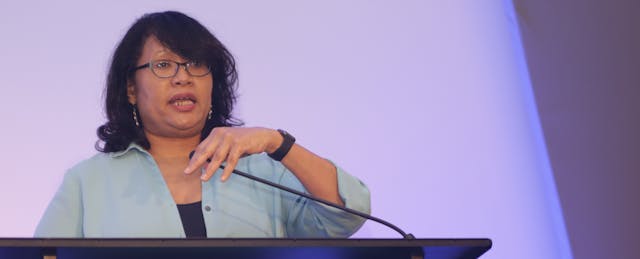Children often live in two different worlds. That was the premise of a video Akimi Gibson, the vice president and education publisher of Sesame Workshop (the nonprofit behind Sesame Street), showed the audience at the EdSurge Fusion conference in Burlingame, Calif.
In the video, singer Ed Sheeran, flanked by Sesame Street characters, sings about the contrast between life at home and life at school for a kid. At home, a child can move around more and talk when she wants. School is a more controlled environment where she has an assigned seat and has to raise her hand.
“For our young ones, going from ‘me’ to ‘we’ can be quite traumatic,” Gibson said. Educators have to think about how children's’ brains work, she argued, and schools need to focus on educating the “whole child,” a term that takes non-academic factors into account, such as health and emotional supports both in school and at home.
Sesame’s whole-child approach, for example, integrates social and emotional development, physical development and health and academics. But for a child to thrive in those three areas, she needs to know how to self-regulate her emotions, behavior and attention. She also needs to master the cognitive processes behind behaviors, such as working memory, Gibson explained.
Working memory is a person’s ability to remember one thing while doing something else. Young children talk to themselves out loud during an activity to help themselves recall directions and things they need to do later. Eventually, they’re able to talk to themselves in their heads. This “private speech” helps children regulate their cognition and behavior, and helps them develop their working memory.
One strategy teachers of young learners can use? Telling kids that it’s “remembering time.” Classrooms would get a bit noisier, as kids have the space to talk to themselves out loud.
There are also general competencies all children must acquire to become resilient, self-efficacious and self-motivated, Gibson said. But educators should find the best way to help each child with those competencies. (In other words: personalize it for them.) Some children might get stuck along the way, so finding the right fit for each child also means educators must be “intentional” about their interactions with students.
Gibson also told the audience to keep in mind that schools “do not work outside the context of a child’s own community,” echoing another whole child tenet. There must be cohesion between what a child learns at school and home, and vice versa.
During a panel after Gibson’s keynote, education leaders from across the country discussed how to implement whole child concepts and social and emotional learning (SEL), a related term around understanding and managing emotions and other soft skills.
Cederick Ellis, the superintendent of McComb School District in Mississippi, said his district worked on providing SEL to three of its schools that were doing personalized learning. Two of the schools faithfully went along with the plan. The principal at the third school did not think SEL would help. At the two schools that enthusiastically implemented SEL, disciplinary referrals and out of school suspensions decreased dramatically. The third principal, having seen the success of those two schools, now wants to implement SEL. Without SEL he said, “we’re failing our children and we will never reach the goal of educating the whole child.”
Barbara Nemko, the Napa County Superintendent of Schools, told the audience she thinks “we’ve been in hell” starting with the advent of No Child Left Behind, the 2000s-era federal law that heavily tied accountability to test scores. She thinks expecting kids, especially kids who have had adverse experiences, such as extreme trauma, to learn in traditional ways without added support “is ludicrous by any standard other than some arbitrary standardized test.” Schools, she argued, can’t ignore those students who are undergoing severe issues in their home and personal lives.
Rosa Perez-Isiah, the principal of Lucille Smith Elementary School in Lawndale, Calif., said adverse experiences not only affect students in poverty, but also students undergoing generational trauma—i.e., their parents grew up in poverty, or were the victims of racism or abuse. The trauma continues for each successive generation of students. And the current political climate, she said, has added another layer of stress for some families.
Her district has put a full-time social worker at every school site. This is the third year of the program, and Perez-Isiah says there’s been a culture shift. Instead of avoiding the discussion of certain topics in school, students advocate for themselves, and parents now openly seek support for issues that might otherwise get ignored at school.


